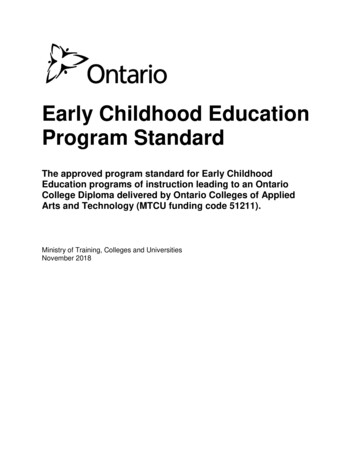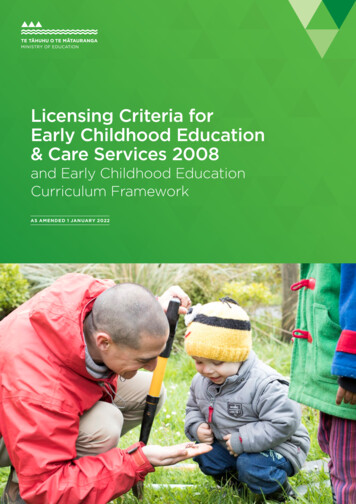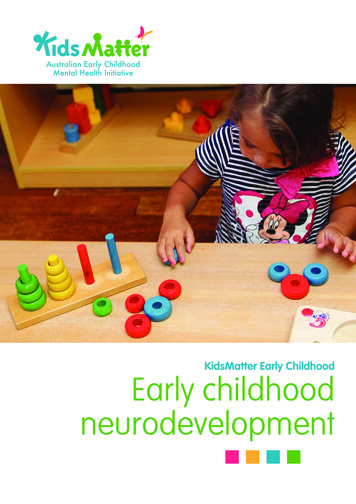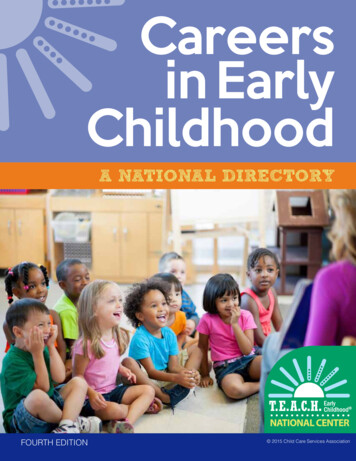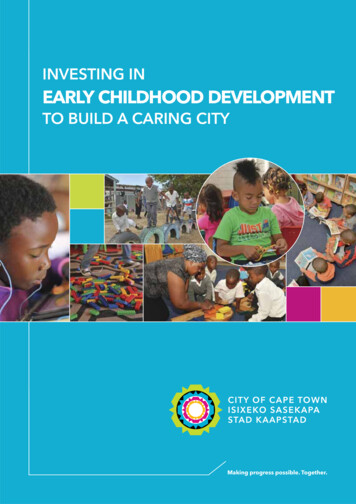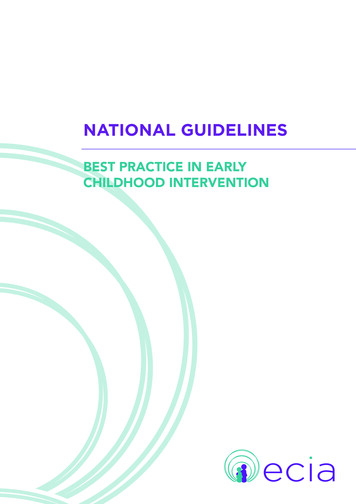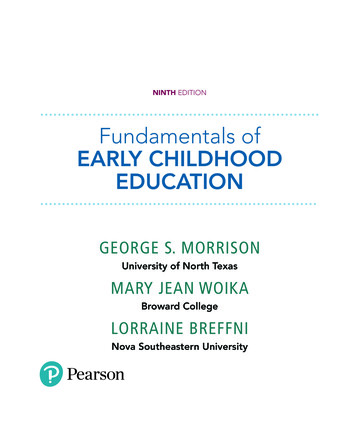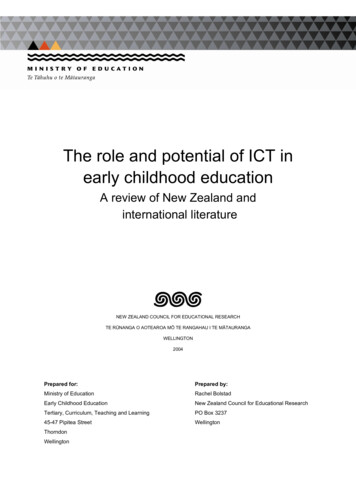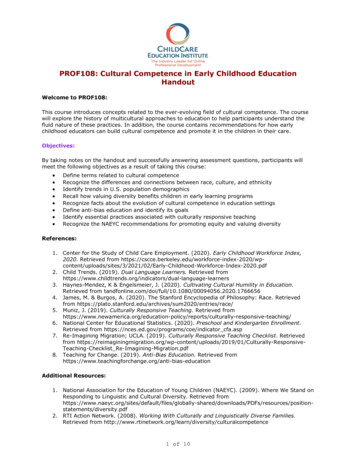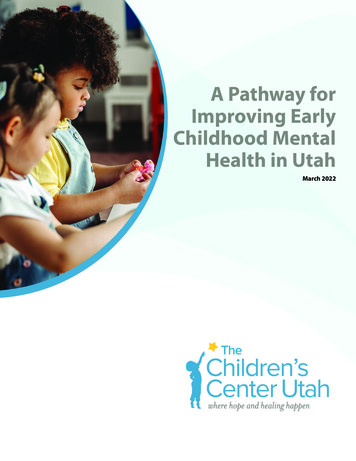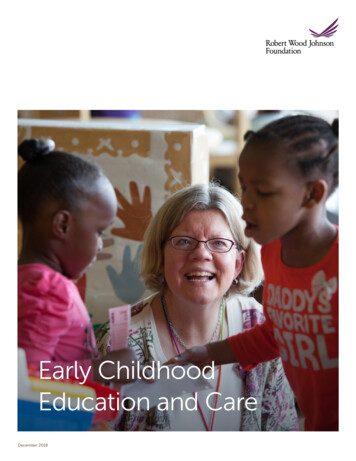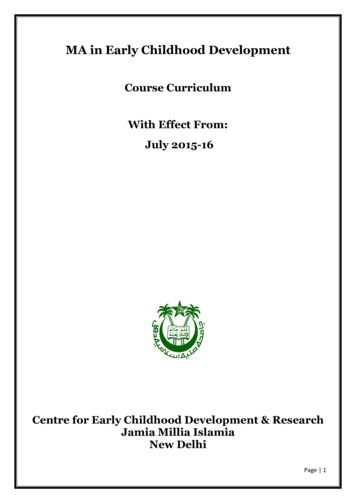
Transcription
MA in Early Childhood DevelopmentCourse CurriculumWith Effect From:July 2015-16Centre for Early Childhood Development & ResearchJamia Millia IslamiaNew DelhiPage 1
MA in Early Childhood DevelopmentGlobally, the early years (from birth to eight years of age) are acknowledged to be the mostcritical years for lifelong development. The criticality of the early years has been recognizedby international conventions such as the UNCRC, EFA and the MDG. The UNCRC clearlyrecognizes the centrality of ECD by articulating the rights of survival, protection, growth,development and participation. The EFA recognizes the importance of the early years withthe year 2000 Jomtien Declaration that ‘Learning begins at birth’ and the MDG recognizesnutrition as a key ECD goal.In the above context the Master’s programme in Early Childhood Development has beendesigned as a cutting edge course to develop in the students the knowledge, attitudes and avaried skill set to work as ECD professionals in diverse settings. It is an interdisciplinarycourse aimed at enabling the student to understand the complexity of the contexts in whichyoung children live and equipping them to make interventions based on a systems approach.Objectives of the course:a. To generate a holistic understanding of contexts and issues in the field of earlychildhood development from an interdisciplinary perspectiveb. To develop knowledge, attitudes, values and skills relevant to the professional practicein early childhood development and to critically apply theoretical constructs topracticec. To engage in self-reflective practice with children and families in micro and macrocontexts and provide interventions guided by rights based approachd. To identify contemporary concerns in the field of early childhood development andundertake researchChoice Based Credit SystemEffective from July 2015, the CECDR shall be implementing the choice based credit systemwherein the student would have the liberty to acquire four credits in each semester from acognate / analogous Department / Centre of the university. Students are advised to get intouch with the students’ advisor to make an informed choice.Page 2
SYLLABUS 05IIIIIEL-01ECD-201ECD-202ECD-203ECD-204Elective #Child in the Socio-Political-Cultural Context*Health, Nutrition and Care during Early ChildhoodCurriculum and Pedagogy during Early ChildhoodYears – Part IResearching with ChildrenECD-205ECD Practice IIEL-02Elective #ECD-301Curriculum and Pedagogy during Early ChildhoodYears – Part IIECD Policy and Programmes*Communication, Guidance and CounsellingECD Practice IIIECD-302ECD-303ECD-304IVCourse TitleThe Child: Physical, Motor and PerceptualDevelopmentThe Child: Development of Cognition, Intelligence andCreativity *The Child: Development of Relationships, Self andEmotionsThe Child: Language DevelopmentECD Practice IEL-03ECD-401ECD-402ECD-403ECD-404Elective #Inclusive Practices*Programme Planning and OrganizationalManagementDissertationECD Practice IVEL-04Elective #CourseCore CourseNatureTheoryCredits2Core CourseTheory4Core CourseTheory4Core CourseSkill EnhancementcourseChoice Based CourseCore CourseCore CourseCore 4Core CourseTheory4Ability EnhancementcourseChoice Based CoursePractical2Theory4Core CourseTheory4Core CourseCore CourseSkill EnhancementcourseChoice Based CourseCore CourseCore 4Core CourseAbility EnhancementcourseChoice Based CourseTheoryPractical44Theory4Total80* Elective papers offered by the centre to students outside the CECDR#Elective papers offered by other departmentsPage 3
Paper No. ECD-101TheoryName of the Course:The Child: Physical, Motor and Perceptual DevelopmentSemester:ICredits:2Objectives of the Course: At the end of this course, the student will be able to:i. State the basic principles, concepts, stages and issues in child development, the significance and scopeof the discipline of child development and its interdisciplinary natureii. Explicate the implications of environmental and biological influences on developmentiii. Describe physical, motor and perceptual development during infancy, preschool and middle childhoodyearsUnit I: Basic Concepts, Prenatal Development and the newborna. Introduction to periods/stages of development, developmental domains, meaning of growth anddevelopment, basic issues in development, principles of growth and development, influences ondevelopment – heredity/biological/maturation, environment and their interaction, canalization,reaction range, genetic environment correlationb. Prenatal Development- Conception and fertilization, stages in and influences on prenataldevelopment, birth process, ensuring birth of healthy baby, assessing the newborn’s physicalcondition: The APGAR Scorec. The Newborn - Adjustments related to birth, reflexes and states, perceptual and motor abilities,newborn’s routine, careUnit II: Physical, Motor and Perceptual Development during Infancy, Preschool and Middle Childhood Yearsa. Physical growth - Changes in body shape, size and proportion, individual and sex differences, structureof the brain and its development, lateralization and brain elasticity, development of internal organs,skeletal growth, muscles, bones, teeth, factors affecting physical developmentb. Motor and perceptual development – Development of gross and fine motor abilities; development ofperceptual abilities - touch, vision, hearing, smell and tastec. Other physiological changes, gender differences, body imageStructure of Internal Assessment: Test / Assignment / Presentation/ Field Visit etc (12marks)Page 4
Recommended Readings : Aries, P. (n.d.). Centuries Of Childhood New York: Knopf. Bee, H. (1995). The Developing Child, Harper Collins College Publishers. Berk, L. E. (2009). Child Development. 8th ed. Pearson Education, Inc. Bruner J.S. (1996). The Culture of Education. USA: Harvard University Crain, W. (2014). Theories of Development: Concepts and Applications, England: Pearson Doherty, J. & Bailey, R. (2002). Supporting Physical Development and Physical education in Early Years.Open University Press: UK. Hurlock, E. B. (1978). Child Growth and Development. Tata McGraw-Hill Education: New Delhi. Nisha, M. (20006). Milestones of child development. Kalpazz Publication: Delhi. Santrock, J.W. (2010). Child Development: An Introduction. McGraw-Hill EducationPage 5
Paper No. ECD-102TheoryName of the course:The Child: Development of Cognition, Intelligence and CreativitySemester:ICredits:4Objectives of the course: At the end of this course, the student will be able to:i.Critically evaluate theoretical frameworks describing development of cognition, learning, intelligence,creativityii. Describe the educational implications of these various theoretical frameworks that form the basis ofearly learning experiencesiii. Understand the socio-cultural influences on cognition, learning, creativity and intelligenceUnit I: Theories of Cognition and Learning and Cultural Influences - Ia. Meaning of learning and cognitionb. Behaviourism and social learning theoriesc. Piaget’s Approach to Intellectual Developmentd. Information processing approaches to learning and cognitionUnit II: Theories of Cognition and Learning and Cultural Influences - IIa. Vygotsky’s Socio-Cultural Theory of Cognitive Development and Neo Vygotskian approachesb. Bruner’s and Ausubel’s perspectives on learning and cognitionc. Educational implications of various theories; comparative analysis of theories on basic issues in childdevelopment; cultural influences on cognitionUnit III: Intelligence and Creativitya. Meaning and concept of intelligence, theories of Intelligence ( Spearman G factor theory, Thurstone’sPrimary Mental abilities, Guilford’s model of Intelligence, Cattell’s Fluid and Crystallised Intelligence,Gardener’s theory of Multiple intelligence, Sternberg’s Triarchic theory of Intelligence )b. Measurement of intelligence, early intervention and intellectual development, factors influencing IQc. Creativity: Meaning and components of creativity, fostering creativity in early years.d. Culture and Intelligence; Culture and creativityStructure of Internal Assessment: Psychological assessment and familiarisation with Intelligence tests will bepart of internal assessmentTest / Assignment / Presentation/ Field Visit etc (25 marks) Recommended Readings: Berk, L.E. (2013), Child Development, Pearson EducationPage 6
Santock, J.W. (2010). Child Developmnt: An Introduction McGraw-Hill Education Crain, W. (2014). Theories of Development: Concepts and Applications, England: Pearson Ginsburg, H. & Opper, S. (1988) Piaget’s Theory of Intellectual Development, Parentice-Hall Elkind, D (1976). Child Developmnt and Education: A Piagetian Perspecive. Oxford University Press. Donaldson, M. (1978). Children’s Minds. Fontana Press Vygotsky, L.S. (1978). Mind in Society - Development of Higher Psychological Processes, USA: HarvardUniversity Press Wertsch, J.S. (1985) Vygotsky and the Social Formation of Mind, USA: Harvard University Press Bruner J.S. (1996). The Culture of Education. USA: Harvard University Sternberg, R.J. (2000) Handbook of Intelligence, USA: Cambridge University Press Luria, A. R.( 1976). Cognitive Development: Its Cultural and Social Foundation. USA: CambridgeUniversity Press Wright, S. (2010). Understanding Creativity in Early Childhood. London: Sage Sternberg, R.J (1999). Handbook of Creativity. Cambridge University Press Duffi, B. (2006). Supporting Creativity and Imagination in the Early Years. Open University PressPage 7
Paper No. ECD-103TheoryName of the course:The Child: Development of Relationships, Self and EmotionsSemester:ICredits:4Objectives of the course: At the end of this course, the student will be able to:i.Describe varied conceptions of children and childhoodii. Understand development of children up to eight years of age in social and emotional domains withreference to individual differences and cross cultural perspectives with an emphasis on reciprocity thatfosters socialisation and identity developmentiii. Critically evaluate theoretical frameworks describing development of personality and humanbehaviouriv. Have the exposure of using various techniques of child studyUnit I: Historical foundations of childhood and contexts for Development in Early yearsa. Historical conceptualization of children and childhood: Western and Indian Thoughts; Culturalvariationsb. Bronfenbrenner’s Ecological systems theory, Contexts for development: Micro-contexts (Family,peer group, school, neighbourhood) and Macro contexts ( Legal and political systems, culture,religion, media, values and beliefs)c. Child rearing practices and Parenting styles, Cultural variationsUnit II: Development of Relationships, Emotions and Selfa. Development of attachment, Bowlby’s ethological theory, factors influencing security of attachment inearly years.b.Emotional development in early childhood years, temperament and behaviour, emotional andbehavioural difficulties in early childhoodc. Development of self and social understanding in early childhood years, Gender development in earlyyears, Play as a context for social and emotional development, Types of play.Unit III: Understanding Personality and Behaviour in the Cultural Contexta. Psycho analytic and psycho-social frameworksb. Humanistic approaches, Behaviourism, Social Learning theoriesPage 8
c. Social cognition; Theory of mind; Development of morality; morality as social understanding- Piaget’sand Kohlberg’s theoriesStructure of Internal Assessment: Test / Assignment / Presentation/ Field Visit etc (25 marks)Recommended Readings: Bandura, A. (1976) Social Learning Theory. Prentice-Hall. Bronfenbrenner, U. (1979).The Ecology of Human Development.Cambridge: HarvardUniversity Press. Corsaro, W.A. (1997). The Sociology of Childhood. New Delhi: Pine Forge Press. E. Tory Higgins, William W. Hartup & Diane N. Ruble (1985) Social Cognition and SocialDevelopment: A Sociocultural Perspective (Cambridge Studies in Social and EmotionalDevelopment). Cambridge University Press. James Midgley (2014) Social Development: Theory and Practice (ISBN-13: 978-1412947787) Sarane, S. B. (1975). Social context of Childhood Precedings of the American PhilosophicalSociety, Vol119 No .5, 419-429. Saraswathi, T.S. (ed.). (n.d.). Cross-Cultural Perspectives in Human Development - Theory,Research and Application. New Delhi. Thousand Oaks. London: Sage Publication. Sudhir Kakar (1983) The Inner World: A Psychoanalytic Study of Hindu Childhood and Society.Oxford University Press, USAPage 9
Paper No. ECD-104TheoryName of the course:The Child: Language DevelopmentSemester:ICredits:4Objectives of the course: At the end of this course, the student will be able to:i.Describe the nature, structure and function of language, and theories of language developmentii.Explain the stages of language acquisition and influences on language developmentiii.Understand the interrelationship between language, culture and societyUnit I: Language and Communicationa. Types of communication; characteristic features of human language (Hockett), structure and functionsof language, language areas in brain, critical period in language learning (CPH)b. Theories of language development: behaviourist, nativist, and interactionist approachesc. Influences on language developmentUnit II: Language Acquisitiona. Acquisition of language: universal and specifics in language acquisitionb. Stages in language acquisition: Pre-linguistic development - phonological, semantic, grammatical,pragmaticc. Development of meta-linguistic awarenessUnit III: Language and Societya. Bilingualism and multilingualism - Impact on development, code switchingb. Language and dialect; language and powerc. Language, cognition and culture - interrelationshipsStructure of Internal Assessment: Test / Assignment / Presentation/ Field Visit etc (25 marks)Page 10
Recommended Readings : Ambron, S.R. (1975). Child Development, Rinchart Prep, San Francisco. Aries, P. (n.d.). Centuries Of Childhood New York: Knopf. Bee, H. (1995). The Developing Child, Harper Collins College Publishers. Berk, L. E. (2009). Child Development. 8th ed. Pearson Education, Inc. Berry, J.W. & Dasen, P.R. (1974). Culture and Cognition: Readings in Cross- culturalpsychology. London: Methuen & Co. Chaudhary, N. (2004). Listening to culture: Constructing Reality from Everyday Talk. NewDelhi: Sage. Craig (Ed.). (1985). Human Development – theories of Human development, 2nd Edition: JohnWiley and Sons. Crain, W. (1992). Theories of development, Concepts and Applications. New Jersey: PrenticeHall. De Villiers, P.A. & De Villiers, J.G. (1979). Early Language. Cambridge: Harvard UniversityPress. Denscombe, M. (1999). The Good Research Guide, Viva Books. Elliot, A.J. (1981). Child language. Cambridge University Press: Cambridge. Gould, S. J. (1996). The Mismeasure of Man, Norton. Hetherington, E.M. & Parke, R.D. (1986). Child Psychology: A contemporary viewpoint, McGrawHill. Hurlock, E.B. (2006). Developmental Psychology – A life span approach. New Delhi: Tata Mc.GrawHill Publishing Company. James A. & Prout, J. (Ed.). (1990). Constructing and Reconstructing Childhood. London: FalmerPress. Kakkar, S. (1997). Culture and Psyche – Selected Essays. Delhi: Oxford University Press Khalakdina, M. (2008). Human Development in the Indian Context: A Socio Cultural FocusVolume I, Sage Publications. Menon, U. (2003). Morality and context: A study of Hindu Understandings. In J. Valsiner andK. Connolly, (Eds.) Handbook of Human Development, (pp. 431-449). London: Sage. Moghaddam, F.M. (2005). Great Ideas in Psychology: A cultural and historical introduction.Oxford England: Oneworld .Page 11
Mussen, P.H., Conger, J.J. & Kagan, J. (1978). Child Development and Personality. New York: Harperand Row Publishers. Nanda, V.K. (1998). Development of Interactive Abilities in Children. New Delhi: AnmolPublications. Papalia, D. E. (1986). A Child’s World,n 4th Editio., New Delhi: McGraw Hill Book Company. Paula, S. F. (Editor-in-chief) (2004). Encyclopedia of Children and Childhood – In history and Society(Vol 1- III). New York: Macmillan Rice, F.P. (1998). Human development. Prentice Hall. Roland, A. (1996). Cultural Pluralism and Psychoanalysis. New York: Routledge Santrock, J.W. & Yussen, S.R. (1988). Child Development: An Introduction. Iowa: Wm. BrownPublishers. Saraswathi, T. S. (Ed.). (2003). Cross- Cultural Perspective in Human Development. New Delhi:Sage.Sharma, A. (2001). Indian Psyche of Childhood. New Delhi: Global Vision Publishing House. Shweder, R.A. and LeVine, R.A. (1996). Emotion and Culture. Cambridge: CambridgeUniversity Press. Sternberg, R.J. (Ed.) (1999). Handbook of creativity. U.K.: Cambridge University Press. Stewart, Clarke, A. & Friedman, S. (1987). Child Development: Infancy through Adolescence. NewYork: John Wiley and Sons. Sylva, K. & Lunt, I. (1982). Child Development: A First Course, Blackwell Publishers. Valsiner, J. (1989). Human Development and culture. Canada: Lexington Books. Valsiner, J. (2000). Culture and Human Development. London: Sage. Vasta, R. (1992). Six theories of Child Development: Revised Formulations and current Issues.London: Sessica Kingsley Publishers Ltd. Wachs, T.D. (1992). The Nature of Nurture. Newbury Park: Sage. Weisberg, R.W. (1986). Creativity: genius and other myths. NY: FreemanPage 12
Paper No. ECD-105PracticalName of the course:ECD Practice ISemester:ICredits:2Objectives of the course: At the end of this course, the student will be able to:i.ii.Study children using various methods to understand development in different domainsExamine educational implications of child development theoriesPracticali.Study of children’s development across domains (physical-motor, cognitive, language and socioemotional) using observations, performance of children on specific tasks (such as Piaget’sconservation and classification tasks)(The site of the practical would be Jamia Nursery school. This component would require 8 visits ofaround 2-3 hours each)ii.Observation and analysis of teaching learning interactions to become familiar with educationalimplications of child development theories(The site of the practical would be Jamia Nursery school. This component requires 2 visits of 3-4hours each)Assessment: Total marks: 50Assessment structure will be based on Regular conduct of practical and preparation of Practical File (35 marks)Presentation (15 marks)Page 13
Paper No. ECD-201TheoryName of the Course:Child in the Socio-Political-Cultural ContextSemester:IICredits:4Objectives of the Course: At the end of this course, the student will be able to:i.Understand children’s subjective experience, meaning and context of their everyday lifeii.Situate the child in the socio-cultural context – understanding variations as consequences of familypatterns, structure, ecology, practices, socio-economic statusiii.Analyze the impact of development policies on children and childhood, understand issues related tostate budgeting for and investment in childrenUnit 1: Profile of the Child in Indiaa. Demographic and social categorization of children: groupings by age, sex, ability, ecology, ethnicity,indicators of child health, nutrition and education, child sex ratiob. Definitions, categories and issues of children in need of care and protectionc. Children and childhood in situations of natural, man- made disasters and political unrest and its impacton child’s well being.Unit 2: Socio-Cultural Context of Childhooda. Varied socio-cultural contexts and their impact on children’s lives, experiences and childhood; culturalconstruction of childhood, value placed on children and expectationsb. Role of cultural values, traditions and attitudes on parenting, ethno theories of parenting, and childrearingc. Family patterns, structure and dynamics as influencing child rearing and children’s experiencesUnit 3: The Child in the Political Contexta. Young child in policies; programmes and child budgeting; politics of educationb. Impact of growth and economic development policies on family, children and childhood: displacement,migration, globalization, liberalization, environmental degradationc. Investing in children: need, challenges and opportunitiesPage 14
Structure of Internal Assessment: Test / Assignment / Presentation/ Field Visit etc (25 marks)Recommended Readings: Atmore, Eric. (1998). Reconstructing Early Childhood Development Services in South Africa: FromApartheid to Democracy. International Journal of Early Years Education, 6(3): 291-98. Bronfenbrenner, U. (1979). The Ecology of Human Development. Cambridge: Harvard UniversityPress. Corsaro, W.A. (1997). The Sociology of Childhood. New Delhi: Pine Forge Press. Eldering L. & Leseman, P. (n.d.). Effective Early Education: Cross-Cultural Perspectives. New York:Falmer Gupta, A. (2006). Early Childhood education Post Colonial Theory and Practice in India. PalgravePublications. Roy, P.K. (Ed.) (2000). The Indian family: Change and persistence. New Delhi: Gyan. Sarane, S. B. (1975). Social context of Childhood Precedings of the American Philosophical Society,Vol119 No .5, 419-429. Seymour, S.C. (1999). Women, Family, and Child Care in India: A World in Transition. New York:Cambridge University Press. Sharma, D. (ed.) (2004). Childhood, family and sociocultural change in India- Reinterpreting the innerworld. Delhi: Oxford University Press. Super, C.M & Harkness, S. (1996). Parents' Cultural Belief Systems. New York: The Guilford Press. Saraswathi, T.S. (ed.). (n.d.).Cross-Cultural Perspectives in Human Development - Theory, Researchand Application. New Delhi. Thousand Oaks. London: Sage Publication Viruru, R. (2001) Early Childhood education Post Colonial Perspectives from India, Sage Publications.Page 15
Paper No. ECD-202TheoryName of the Course:Health, Nutrition and Care during Early ChildhoodSemester:IICredits:4Objectives of the course: At the end of this course, the student will be able to:i.Explain the dynamic interaction between child health, nutrition and developmentii.Describe the basic concepts in nutrition and plan balanced diets across age groupsiii.Implement care practices to promote health of children and women across social contextsUnit 1: Health, Nutrition and Developmenta. Meaning of health and nutrition, dimensions of health, health-sickness spectrum, determinants ofhealth, nutritional status, mental health and well beingb. Relationship between maternal and child health, nutrition, survival and development; lifespanapproach to health and nutritionc. Standards and tools for assessing children’s health, growth and nutritional status; assessment ofnutritional status-anthropomorphic measuresUnit 2: Promoting Child and Maternal Nutritiona. Basic concepts in nutritionb. Nutrition during infancy, early childhood, middle childhood, pregnancy and lactation, planningbalanced dietsc. Nutrition related disorders in childhood; maternal and child nutrition programmes and provision ofnutrition servicesd. National nutrition surveys-National nutrition board, national institute of health and family welfare andDLHSUnit 3: Promoting Child and Maternal Healtha. Common childhood illnesses; their prevention and management; Care practices and health promotionto improve young lives in urban spaces; chronic medical conditions (obesity, diabetes, cancer)Page 16
b. Healthcare during pregnancy and lactation; maternal and child health programmes and provision ofhealth services ; Nutrition advocacy-behaviour change communication; Health care system in Indiahealth based ,nutrition(food) based and education based interventionc. Challenges in the field of Maternal and child health and nutrition; myths and practices related to careStructure of Internal Assessment: Test / Assignment / Presentation/ Field Visit etc (25 marks)Recommended Readings: Bamji M.S., Rao, N.P., & Reddy, V. (2003). Text book of Human Nutrition,2nd Edn., Oxford and IBHPublishing Co Pvt. Ltd. Ministry of WCD. (2007). Dietary Tips for Better Health, Food and Nutrition Board, Govt. of India. Gibson, R.S. (2005). Principles of Nutritional Assessment, 2nd Edn. ,Oxford University Press. ICMR. (2010). Nutrient Requirements and Recommended Allowances for Indians. John, S. (1998). ‘Child Development’ , 8th Edn., Mc-Graw Hill. King, Maurice, & Felicity. (n.d.). Primary Child Care Book One., England: TALC. Kliegman, Behrman, Jenson, Stauton, & Nelson.(2007). Textbook of Pediatrics, 18th Ed., Publ.Saunders – Elsevier. National Institute of Child Health and Human Development Early Child Care Research Network. (2005).Duration and developmental timing of poverty and children’s cognitive and social development frombirth through third grade. Child Development; 76:795-810 National Institute of Nutrition. (1998). NIN Dietary Guidelines for Indians- A Manual. Schor, E.I. (2004). Rethinking well-childcare. Pediatrics; 114:210-216. Shonkoff, J.P. & Phillips, D. (eds). (2000). From Neurons to Neighbourhoods: The Science of EarlyChildhood Development. Washington, DC: National Academies Press. Wadhwa, A. & Sharma, S. (2003). Nutrition in the Community- A Text Book, Elite Publishing House Pvt.Ltd. Walker, W.A. & Watkins, J.B. (2003). Nutrition in Pediatrics: Basic Sciences and Clinical Applications, 3rdEdn., Hamilton, Ontario: BC Decker Inc. Webster, G. et al., (2006). Oxford Handbook of Nutrition and Dietetics, Oxford University Press.Page 17
Paper No. ECD-203TheoryName of the Course:Curriculum and Pedagogy during Early Childhood Years – Part ISemester:IICredits:4Objectives of the course: At the end of this course, the student will be able to:i. Study the principles and theoretical paradigms underlying early childhood education (ECE)ii. Plan and implement activities and learning experiences that would promote the development of adiverse group of children across domains during infancy and preschool years.iii. Understand principles of curriculum planning and evaluation and to be able to design a developmentallyappropriate curriculum, and evaluate children’s learning and progress.Unit 1: Themes and Issues in ECCEa. Significance and scope of ECCE; Need and importance of stimulation programmes for infants andtoddlers (Birth-three years),b. philosophical and theoretical perspectives in ECCE;c. ECCE in India, ECCE Policy, Forms and components of ECCE servicesd. Issues in ECCE - access, provisions, quality, teacher training, recognition and accreditation ofprogrammes issues; addressing diversity, practicing equity and inclusion; transition from home topreschool to primary schoolUnit 2: Designing and Transacting Teaching-Learning Experiencesa. Play and learning-importance of play for overall development and learning,b. Organising space for teaching-learning transactions, aspects of teaching-learning transactions-Physicalenvironment, daily schedule, curriculum, strategies for managing childrenc. Planning experiences/activities to foster development across domains; Developing concepts related toscience, math, language, self and environmentd. use of developmentally and culturally appropriate teaching learning materials and equipments, use ofstory-telling, art, theatre, music and dancePage 18
Unit 3: Curriculum Planning and Evaluationa. Principles of curriculum planning (long term goals, short terms goals, monthly, weekly and daily planstypes of planning-webbed planning, theme based and project based planningb. Approaches and Curriculum Models like Reggio-Emila, High-scope, TeWhariki, Waldorf, Bank Streetc. Assessment and Evaluation in ECCE- Assessing Children’s progress and evaluating ECCE programmesd. Maintaining records, Communication with parentsStructure of Internal Assessment: Test / Assignment / Presentation/ Field Visit etc (25 marks)Recommended Readings: David, T. (1989). Teaching Young Children. New Delhi: Sage.Donaldson, M. (1987). Children’s Minds. London: Fontana Press: Hraper Collins.Gijubhai, B. (2009). Diwa Swapna. Gujarat: Adarsh Prakashan.Gupta, A. (2006). Early Childhood Education: Post colonial theory and teaching practices in India –Balancing Vygotsky and Vedas. New York: Palgrave Macmillan.Holt, J. (1990). Learning all the time. New York: Addison – Wesley Publishing Co.Johansen, E. & Samuelsson, P.I. (2006). Play and learning – inseparable dimensions in preschoolpractice. Early Child Development and Care, 176 (1): 47-65.Kaul, V. ( 1994/2010) Early Childhood Education Programme. New Delhi:NCERTKaul, V. & Bhatnagar, R. (n.d). Early Childhood Education : A Trainers’ Handbook. New Delhi:NCERT.Kaul, V. et al. (1998). The Primary Years, NCERT, New Delhi.Tarabai, M. (1961). Meadow School , GOI.Montessori, M. (1962). The Discovery of the Child. Chennai:Kalakshetra Publications.Moyles, J. (1989). Just Playing? The Role and Status of Play in Early Childhood Education, MiltonKeynes: OUP.NCERT (2006). Position paper on Early Childhood Education, New Delhi.Penn, H. (2000). Early Childhood services: Theory and practice, Philadelphia:OUPSwaminathan, M. (1980). Play activities for young children, New Delhi: UNICEF.Swaminathan, M. (1998). Ed. The First Five Years: a critical perspective on Early Childhood Care andEducation In India. New Delhi: Sage.Trawick, S. J. (2000). Early Childhood Development (2nd. Ed). New Jersey: Merrill Prentice Hall.Viruru, R. (2001). Early Childhood Education: Post Colonial perspectives from India. New Delhi:Sage publications.World Bank (2004). Reaching Out to the Child, New Delhi: OUP.Page 19
Paper No. ECD-204TheoryName of Course:Researching with ChildrenSemester:IICredits:4Objectives of the course: At the end of this course, the student will be able to:i)ii)iii)iv)Understand the nature, process and significance of social research with children.Design
MA in Early Childhood Development Globally, the early years (from birth to eight years of age) are acknowledged to be the most . E. B. (1978). Child Growth and Development. Tata McGraw-Hill Education: New Delhi. Nisha, M. (20006). Milestones of child development. . Name of the course: The Child: Development of Cognition, Intelligence and .
